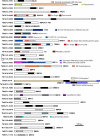RNA-binding domain proteins in Kinetoplastids: a comparative analysis
- PMID: 16339728
- PMCID: PMC1317496
- DOI: 10.1128/EC.4.12.2106-2114.2005
RNA-binding domain proteins in Kinetoplastids: a comparative analysis
Abstract
RNA-binding proteins are important in many aspects of RNA processing, function, and destruction. One class of such proteins contains the RNA recognition motif (RRM), which consists of about 90 amino acid residues, including the canonical RNP1 octapeptide: (K/R)G(F/Y)(G/A)FVX(F/Y). We used a variety of homology searches to classify all of the RRM proteins of the three kinetoplastids Trypanosoma brucei, Trypanosoma cruzi, and Leishmania major. All three organisms have similar sets of RRM-containing protein orthologues, suggesting common posttranscriptional processing and regulatory pathways. Of the 75 RRM proteins identified in T. brucei, only 13 had clear homologues in other eukaryotes, although 8 more could be given putative functional assignments. A comparison with the 18 RRM proteins of the obligate intracellular parasite Encephalitozoon cuniculi revealed just 3 RRM proteins which appear to be conserved at the primary sequence level throughout eukaryotic evolution: poly(A) binding protein, the rRNA-processing protein MRD1, and the nuclear cap binding protein.
Figures




Similar articles
-
An RNAi screen of the RRM-domain proteins of Trypanosoma brucei.Mol Biochem Parasitol. 2009 Jan;163(1):61-5. doi: 10.1016/j.molbiopara.2008.09.001. Epub 2008 Sep 18. Mol Biochem Parasitol. 2009. PMID: 18840477
-
Genome-wide in silico screen for CCCH-type zinc finger proteins of Trypanosoma brucei, Trypanosoma cruzi and Leishmania major.BMC Genomics. 2010 May 5;11:283. doi: 10.1186/1471-2164-11-283. BMC Genomics. 2010. PMID: 20444260 Free PMC article.
-
Genome analysis: RNA recognition motif (RRM) and K homology (KH) domain RNA-binding proteins from the flowering plant Arabidopsis thaliana.Nucleic Acids Res. 2002 Feb 1;30(3):623-35. doi: 10.1093/nar/30.3.623. Nucleic Acids Res. 2002. PMID: 11809873 Free PMC article.
-
The Hsp70 chaperones of the Tritryps are characterized by unusual features and novel members.Parasitol Int. 2010 Dec;59(4):497-505. doi: 10.1016/j.parint.2010.08.008. Epub 2010 Sep 8. Parasitol Int. 2010. PMID: 20816852 Review.
-
Nuclear localization signals in trypanosomal proteins.Mol Biochem Parasitol. 2019 Apr;229:15-23. doi: 10.1016/j.molbiopara.2019.02.003. Epub 2019 Feb 14. Mol Biochem Parasitol. 2019. PMID: 30772422 Review.
Cited by
-
An RNA-binding protein complex regulates the purine-dependent expression of a nucleobase transporter in trypanosomes.Nucleic Acids Res. 2021 Apr 19;49(7):3814-3825. doi: 10.1093/nar/gkab181. Nucleic Acids Res. 2021. PMID: 33744953 Free PMC article.
-
Trypanosoma brucei RRM1 is a nuclear RNA-binding protein and modulator of chromatin structure.mBio. 2015 Mar 17;6(2):e00114. doi: 10.1128/mBio.00114-15. mBio. 2015. PMID: 25784696 Free PMC article.
-
Trypanosoma cruzi transcriptome during axenic epimastigote growth curve.Mem Inst Oswaldo Cruz. 2018;113(5):e170404. doi: 10.1590/0074-02760170404. Epub 2018 Apr 9. Mem Inst Oswaldo Cruz. 2018. PMID: 29668769 Free PMC article.
-
Organization and evolution of two SIDER retroposon subfamilies and their impact on the Leishmania genome.BMC Genomics. 2009 May 22;10:240. doi: 10.1186/1471-2164-10-240. BMC Genomics. 2009. PMID: 19463167 Free PMC article.
-
Inhibition of mRNA maturation in trypanosomes causes the formation of novel foci at the nuclear periphery containing cytoplasmic regulators of mRNA fate.J Cell Sci. 2012 Jun 15;125(Pt 12):2896-909. doi: 10.1242/jcs.099275. Epub 2012 Feb 24. J Cell Sci. 2012. PMID: 22366449 Free PMC article.
References
-
- Batista, J. A. N., S. M. R. Teixeira, J. E. Donelson, L. V. Kirchhoff, and C. Martins de Sá. 1994. Characterization of Trypanosoma cruzi poly(A)-binding protein and its genes. Mol. Biochem. Parasitol. 67:301-312. - PubMed
-
- Benz, C., D. Nilsson, B. Andersson, C. Clayton, and D. L. Guilbride. 2005. Messenger RNA processing sites in Trypanosoma brucei. Mol. Biochem. Parasitol. 143:125-134. - PubMed
-
- Berriman, M., et. al. 2005. The genome of the African trypanosome, Trypanosoma brucei. Science 309:416-422. - PubMed
Publication types
MeSH terms
Substances
Grants and funding
LinkOut - more resources
Full Text Sources
Molecular Biology Databases
Miscellaneous

